Meeting Mary Magdalene
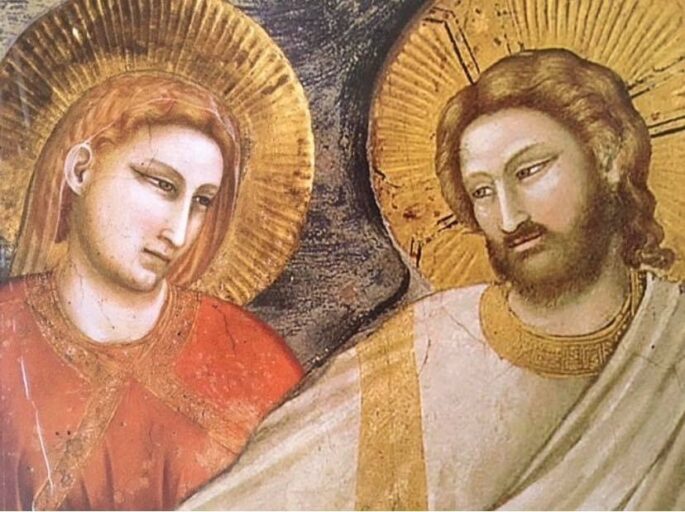
She approached me boldly, hair ablaze, hips swaying. She took my face in her hands and came so close our noses almost touched. We locked eyes for an unforgettable moment. She was gentle but firm, her unflinching gaze penetrating deep within, nothing but love in her eyes.
I felt a rush of emotion flow through me, and tears slid down my face. She held my attention with her long lingering gaze. I was lying on my bed, doing a guided meditation when she entered my mind’s eye and walked towards me until her face was all I could see.

It was an invitation, an opening to dance with her. No music needed. She gave me no words, no guidance or clarity. Just this freedom and liberation through movement. She slowly moved further and further away, dissolving back from where she came, leaving me standing moving, dancing to the sound of my heartbeat.
My mind buzzed with questions as she slowly walked away. Why are you here? What have I done to deserve this meeting? What do you ask of me? She replied with a backward gaze, with the curve of her eyebrow and the toss of her great hair that seemed to say “Remember me. I will show you the way.” Beckoning to me with a cheeky grin, she turned and slowly walked away.
I was hooked, intrigued and a little awe struck. I had to know everything about this incredible enigmatic woman. She slowly moved further and further away, dissolving back from where she came, leaving me standing moving, dancing to the sound of my heart beat.
Meeting Mary Magdalene shook me to my core. It was not the vision itself that I found remarkable.
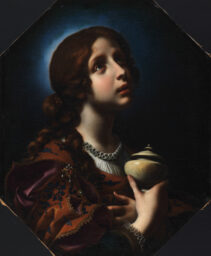
I have spent the last thirty years learning how to communicate with my own spirit guides and guardian angels, connecting with various archangels, ascended masters, gods and goddesses. I learned how to read the Akashic Records (a vast database of everyone’s soul – past, present, and future) and became a professional intuitive and feminine embodiment coach.
‘St. Mary Magdalene’ by Carlo Dolci ( 1660-1670); Fitzwilliam Museum, Cambridge, UK. She holds an unassuming little jar, one of Mary Magdalene’s many symbols. (For more on the jar read my blog: ‘Mary Magdalene, the Anointrix’)
This encounter was spectacularly different. Mary Magdalene had startled me because she had come to me uninvited. I had not called her in or even been interested in her.. I was lying on my bed, doing a guided meditation when she entered my mind’s eye and walked towards me until her face was all I could see. Mary Magdalene came to me in an exquisite vision. It was literally a few split seconds of contact but with all visions of ascended masters it was deeply profound.
Mary Magdalene was the one who initiated contact. Mary Magdalene was the one who initiated contact. Imagine my surprise when this incredible woman locked eyes with me and challenged me to a staring contest.
A thousand different interpretations have played in my mind since. I feel her message is about freedom of movement and fluidity that is so foreign to us now. Every movement we make is choreographed. We lost the old ancient dances in the burning pyres of the Middle Ages. We lost the connection to nature and to our own bodies. This portrait of Mary Magdalene is by .
But Mary Magdalene was a complete mystery to me. Despite years of Sunday School and Religious Studies in my Anglican high school, I knew little of Mary Magdalene. Even after studying comparative religions at university, her presence in the story of Jesus was barely mentioned.
This penitent fallen woman whispered of an unspoken, unsavoury underbelly kept hidden beneath the surface that could still be felt, two thousand years later. But I had no clue what gave me that impression.
It was June 2018 when she strolled into my consciousness. I vowed to go to France, giving myself the arbitrary date of October 2019 – my birthday month. I did not know where I needed to go (or why) but I knew it was important to go there physically.
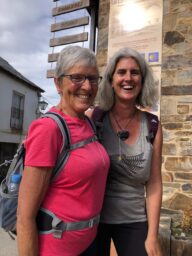
Incredibly, this dream came to fruition, when in August 2019 my mother invited me to walk the Camino de Santiago with only 6 weeks to prepare. Using intuition and where I have been guided to research, I planned our trip in the Languedoc region, contained within the modern-day region of Occitanie of southern France, before walking 780 km across the Pyrenees Mountains and through northern Spain to Santiago de Compostela.
Coincidentally, the route of this Camino was once an ancient divine feminine pilgrimage route to Finistere, or World’s End. Even now, pilgrims on the Santiago de Compostela are given scallop shells to carry with them to identify them as pilgrims. Associated with the goddesses Aphrodite and Venus, the scallop shell was an ancient symbol of the divine feminine.
We live in a time when the truth is coming to light. The discovery of texts the Church tried to ban way back in the 300s, some texts older than the gospels, gives us exciting insights into Jesus’ teachings, his mission and his relationship with his most stellar student, Mary Magdalene.
I did not know why I needed to go to meet Mary Magdalene in France…
The Marys
The disciples were married and had children. Jesus travelled far and wide to teach and heal with a group of followers that included his disciples and their wives.
Jesus’ male disciples would have travelled their family with them as part of their life and ministry. Jesus had women followers who were listened to his teachings and were important enough in his ministry to be named in the gospels.
Travelling with Jesus was a group of women who supported his ministry financially. In the early days of Jesus’ ministry women were already travelling, preaching, healing, and baptising alongside Jesus and his male disciples. A group of women was singled out repeatedly.
These women were referred to: Mary, wife of Joseph and mother of Jesus (Matthew 1:16; Luke 1:41; Acts 1:14), Mary Magdalene (Matthew 27:56.61, 28:1; Luke 8:2; John 20:16), Mary of Bethany, sister of Martha and Lazarus (Luke 10:39-42; John 11; 12:1-8), Mary, mother of James the younger and Joses (Mark 15:40.47; 16:1; Luke 24:10), Mary, the wife of Clopas (John 19:25), Mary, the mother of John Mark (Acts 12:12) and Mary, who worked very hard in Rome (Romans 16:6).

In Luke we learn that this group of women include Mary Magdalene, Joanna, and Susanna. Luke suggests that these women supported Jesus “out of their own means” including Joanna “the wife of Chuza, the manager of Herod’s household” (Luke 8:3).
These women are identified as “they that followed Jesus from Galilee and saw to his needs” (Matthew and Mark) and became known as the Marys.
This painting is called ‘The Still Point — Five Were Wise’ by Michael Malm
These women were not merely in charge of Jesus’ physical needs, cooking, and cleaning. In Luke (8:1-3) these women are referred to as “followers”. In the gospels when women are mentioned the text strongly indicates that the women were vital to Jesus’s ministry.
It is these women who were present in the pivotal moments of Jesus’ arrest, crucifixion, death, entombment, and resurrection. Women are represented as his most faithful followers, even when his male disciples went into hiding.
Jesus chose his disciples based on spiritual understanding and commitment, not gender. This intrinsically feels part of Jesus’ doctrine of faith. This was also the sticking point that many Jews could not embrace, and that drew so many women to his ministry.
We know nothing of the thoughts and desires of these women who served and cared for Jesus. These women were not given a voice. According to the gospels, they were obedient servants who did not get into trouble with their uncontrolled tongues or their wayward bodies.
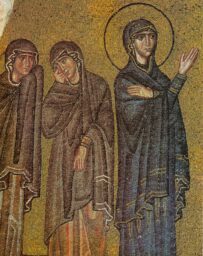
We cannot overestimate the sacrifices these women made to follow Jesus. We know from his male disciples that Jesus demanded his followers abandon family and leave their work to follow him. There was to be no half-measures.
This icon depicts the on the Greek island of Chios (1100)
The Marys had to break Jewish civil law, sever ties with their families and give up their worldly possessions for the greater good. These women bravely broke with Jewish traditions of their society and had no doubt suffered a backlash of indignation and accusation everywhere they travelled.
These women were pushed far into the background by the authors of the gospels, including Mary Magdalene.
So, what do we know about Mary Magdalene?
Mary Magdalene always appears first in lists of women, indicating that she was the most important. Mary Magdalene was the best known of the Marys, but she still featured in only five events in the four gospels: once mentioned by name in Luke and in every one of the gospels during the stories of the crucifixion and resurrection.
According to legend, Mary Magdalene began as an unmarried, independent, wealthy woman. It was scandalous for women to travel independently, especially with men who were not related to them, although there were exceptions made. This act alone would have made Mary Magdalene hamartolos, a Greek word meaning sinner or sinful, but in Hebrew communities it meant a person who was not living according to civil law.
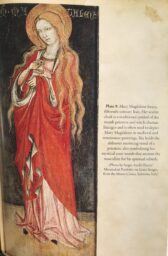 According to ‘The Golden Legend’ compiled by Italian writer and Dominican friar Jacobus de Voragine (c.1230-1298), Archbishop of Genoa, Mary Magdalene: “was born of right noble lineage and parents, which were descended from the lineage of kings…her father was named Cyrus, and her mother Echaris.”
According to ‘The Golden Legend’ compiled by Italian writer and Dominican friar Jacobus de Voragine (c.1230-1298), Archbishop of Genoa, Mary Magdalene: “was born of right noble lineage and parents, which were descended from the lineage of kings…her father was named Cyrus, and her mother Echaris.”
Interestingly, Voragine’s description of Martha is similar although her parents are slightly different (Syro a “duke of Syria and places of maritime” and her mother was Eucharia) suggesting Voragine thought they were sisters.
Mary Magdalene was descended from a royal Canaanite family, possibly Syrian. Mary Magdalene could have been a Jew by birthright but as a citizen of Hellenized Syria she would have been assimilated into Greek and Syrian cultures.
P. Hallet in ‘Women’s Lives in the Ancient Mediterranean’ observes that in Hebrew culture “certain women, specifically those from families possessing power and privilege, shared qualities and traits with men, a notion which in turn facilitated and justified elite women’s participation in what were ordinarily deemed to be masculine pursuits.”
Women born to wealth and status had greater freedom, more opportunities and less societal restrictions than the poor. J. P. Hallet suggests there was greater egalitarianism in religious sects, inspired by the gods and goddesses of early Greek pantheon who coexisted as equals.

As a Hellenistic nation, Israel was aware of the ideal of gender equality in the Greco-Roman world. Hallet observed that pagan religions were not only open to elite women but any female worshipper whether they were a slave, a victim, a lover, a married woman, or a lower-class woman.
I love this image from the Last Supper by Jaume Huguet (1445–1492), depicting exactly how close Mary Magdalene was to Jesus.
There is so much to this woman!
The Only One Who Stood Firm
In the final week of Jesus’ life, leading up to his crucifixion and resurrection, Mary Magdalene is often right up close to the action. Mary Magdalene is often as a solitary figure or a group of women. Mary Magdalene held her ground beside her Rabboni. She was not frightened off as the others were.
When Jesus was arrested the disciples deserted him and fled except one disciple. All four gospels name Mary Magdalene as one of the few who remained faithful and fearless, staying with Jesus.
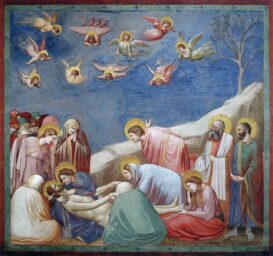
When Jesus was hung on the cross at Golgotha (which means the place of the skull), only those closest to Jesus were allowed to stand beneath the cross. Mary Magdalene stood at the foot of the cross or witnessed Jesus’ ordeal from a distance.
The disciples were conspicuously absent with the only men named present being Joseph of Arimathea and Nicodemus.
‘The Lamentation over the Dead Christ and The Resurrection’ (c. 1305) by Giotto, Scrovegni Chapel, Padua.
After Jesus supposedly had died he was taken to the tomb Mary Magdalene and the other Mary sat in vigil outside the tomb, unable to lose hope, unable to fathom what had occurred, unable to let Jesus go.
The Empty Tomb
 Even more surprising, in the gospels of Matthew and Mark, it is Mary Magdalene, “the other Mary” and Salomé who visit the tomb with jars of perfumed oil to anoint Jesus’s body the following morning but found the tomb empty (Matthew 27:61, Mark 15:). Luke referred to the women as “the women who had come with Jesus from Galilee” (Luke 8:2, 23:55, 24:10).
Even more surprising, in the gospels of Matthew and Mark, it is Mary Magdalene, “the other Mary” and Salomé who visit the tomb with jars of perfumed oil to anoint Jesus’s body the following morning but found the tomb empty (Matthew 27:61, Mark 15:). Luke referred to the women as “the women who had come with Jesus from Galilee” (Luke 8:2, 23:55, 24:10).
‘Resurrection of Christ and Women at the Tomb’ (1439-1443) by Fra Angelico in cell 8, Museo di San Marco, Florence, Italy.
Why is this important?
According to Jewish tradition, only his mother, his sister or his wife would be allowed to anoint his body after the crucifixion. If Mary Magdalene was only one of his close followers she would not have been admitted to the tomb to dress his body. But John (20:15), Mary Magdalene had the right to claim the body of Jesus for burial.
The fact she anointed his body means that she was of the highest standing, higher even than his mother. She must have been his wife, anointing Jesus’ body with precious oils. (For more on the jar read my blog: ‘Mary Magdalene, the Anointrix’)
Mary Magdalene is amongst the women who discover the tomb empty and are told by an angel “Do not be afraid, for I know that you are looking for Jesus, who was crucified. He is not here; he has risen, just as he said. Come and see the place where he lay. Then go quickly and tell his disciples: ‘He has risen from the dead and is going ahead of you into Galilee. There you will see him.’ Now I have told you.”
The First to See the Risen Christ
Predictably, despite the account coming from several eyewitnesses, the women are not believed. In all four gospels the disciples rush to see for themselves but then return home, leaving only Mary Magdalene outside the tomb. Mary was described weeping again, inconsolable in her grief.
A voice from far away spoke to Mary, saying “Woman, why weepest thou?” Blinded by tears Mary and lost in her misery, she turned towards the voice and replied “Because they have taken away my Lord, and I know not where they have laid him.”
And the voice responded gently saying: “Woman, why weepest thou? Whom seekest thou?” Slowly returning to her body, coming back to the present, Mary mistook him for the gardener, pleaded “Sir, if thou have borne him hence, tell me where thou hast laid him, and I will take him away.”
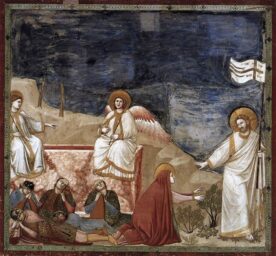 And the voice boomed clear and strong, saying “Mary.” Only then did she wipe her tears away and recognise it was Jesus standing before her, in spirit form, only seen within her mind’s eye. And she cried out in surprise and relief: “Rabboni.” To her astonishment her Rabboni was standing before her.
And the voice boomed clear and strong, saying “Mary.” Only then did she wipe her tears away and recognise it was Jesus standing before her, in spirit form, only seen within her mind’s eye. And she cried out in surprise and relief: “Rabboni.” To her astonishment her Rabboni was standing before her.
Jesus said to her, “Touch me not, for I am not yet ascended to my Father One with my Mother, but go to my brethren, and say unto them, I ascend unto my Parent and your Parent; to my God and your God.” This is fresco No. 35 Scenes from the Life of Christ: 21. The Resurrection (1304-06) painted by Giotto do Bondone in the Cappella Scrovegni (Arena Chapel), Padua.
It was Mary Magdalene who was the first to see Jesus.
Mary Magdalene’s relief that Jesus lived would have been tempered by her fear that even now he would not survive his injuries, or that they would be discovered, and he would still be taken from her.
Her own human need for her beloved, a need that could not be met, would have been a relentless ache in her heart. Even if he lived, Jesus could never again be seen with her. He was a wanted man and for her safety they could never be seen together again.
Apostle to the Apostles
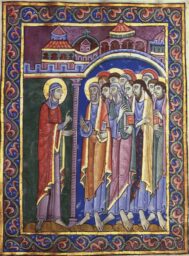
If we are following the gospel version of events, after the crucifixion Mary Magdalene ceases to exist. The Marys cease to exist. Even Jesus’ mother is no longer mentioned.
The women of Jesus’ ministry are no longer part of the recorded history, even in the Acts of the Apostles or the apocryphal texts that attempted to fill in the gaps left in the narrative.
This image is ‘Mary Magdalene announces the Risen Christ’ in the St Albans Psalter from the twelfth century.
What we know of Mary Magdalene after the crucifixion comes from the ‘Gospel of Mary’, a Coptic (Egyptian Christian) codex discovered in Cairo. The first fragment of the ‘Gospel of Mary’ was found by a German collector in an antiquities market in Cairo in 1896, with new fragments found since.
The ‘Gospel of Mary’ was not published until 1955, and another twenty-five years for an English edition. The gospel has been difficult to accurately date. While a Greek fragment, the Rylands papyrus 463, provides evidence of a third-century copy, the original text of the ‘Gospel of Mary’ is thought to be older, possibly from the second century, likely around 150 CE.
 For context, the canonical gospels of the New Testament of the Bible were probably written between 66-110 CE. This puts their composition within the lifetimes of eyewitnesses, including Jesus’s own family, and were the product of oral and written transmissions.
For context, the canonical gospels of the New Testament of the Bible were probably written between 66-110 CE. This puts their composition within the lifetimes of eyewitnesses, including Jesus’s own family, and were the product of oral and written transmissions.
Saint Mary Magdalene by Bergognone (c.1515)
The ‘Gospel of Mary’ describes a gathering of the disciples shortly after Jesus’ crucifixion at Bethany. Mary Magdalene sought out the disciples and announced that she had seen Jesus. Jesus had spoken these things to her and commanded her to announce his resurrection from the dead. Unlike Mary Magdalene, the disciples had scrambled after the arrest and gone into hiding.
While Mary Magdalene was inflamed by the Good News Jesus had asked her to transmit, “they were grieved and wept greatly, saying, ‘how shall we go out and preach the gospel of the Kingdom of the Son of Humanity? If they did not spare him, how will they spare us?’” (Gospel of Mary 5:1).
 At the gathering at Bethany it was Mary Magdalene who stood up and spoke, taking her rightful place as leader of the disciples. Mary Magdalene cleared her throat, raised her hand in the gesture of a teacher and preacher and she demanded their attention. Mary Magdalene accepted the mantle of apostles to the apostles her rabboni had given her.
At the gathering at Bethany it was Mary Magdalene who stood up and spoke, taking her rightful place as leader of the disciples. Mary Magdalene cleared her throat, raised her hand in the gesture of a teacher and preacher and she demanded their attention. Mary Magdalene accepted the mantle of apostles to the apostles her rabboni had given her.
‘Saint Mary Magdalene teaching the Apostles about Resurrection’, fresco, Decani Monastery, Serbia, fourteenth Century.
Mary Magdalene passed on the message Jesus had given to her. It was Mary Magdalene who was commanded by Jesus to announce his resurrection. It was Mary Magdalene who Jesus asked to tell the disciples to spread word of the resurrection. At a time when women’s testimony was not legally valid, Mary Magdalene spoke of wisdom to the disciples that had not even been shared to his male disciples.
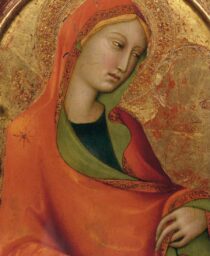 But the disciples were incredulous that Jesus chose to appear to her, a woman. They lashed out jealously. Mary Magdalene is called a heretic and liar for the “strange teaching” she described. The disciples could not even contemplate the message she shared with them and the spiritual map that had been gifted to Mary Magdalene alone.
But the disciples were incredulous that Jesus chose to appear to her, a woman. They lashed out jealously. Mary Magdalene is called a heretic and liar for the “strange teaching” she described. The disciples could not even contemplate the message she shared with them and the spiritual map that had been gifted to Mary Magdalene alone.
Detail from St Mary Magdalen by Lippo Memmi (1291-1356).
The disciples could not begin to appreciate the spiritual wisdom and talents of this woman who had reached such dizzying heights of spiritual enlightenment with their master Jesus.
In the ‘Gospel of Mary’ Levi reminded them of Jesus’ message, encourages the disciples to “put on perfect humanity (anthropos) and acquire it as she has done.” He advised them to go forth to preach Jesus’ message as he related it to them, without making any other rule or law beyond what Jesus had given them.
For Levi Mary Magdalene was their leader, an example and role model to emulate and learn from. He wanted to achieve what she had and saw her as evidence of what Jesus’ teachings could achieve.
Sadly, the disciples did not agree with Levi and did not unite behind Mary Magdalene. Mary Magdalene was punished for her outspokenness. Almost as soon as Jesus was no longer present to defend her, Mary Magdalene became the target and was cast aside once more by all the disciples.
Mary Magdalene was rejected as the chosen successor of Jesus. Instead of becoming the Apostle to the Apostles, Mary Magdalene was snubbed, and Peter was given the leadership role. If this is what Jesus had wanted, he would have appeared to Peter first.
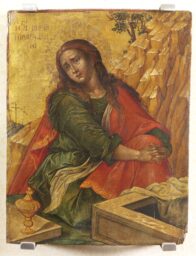
As a result, we have been denied the fruits of Jesus’ labours and the gnosis that he worked so tirelessly to spread through his example and his teachings. This was a spiritual and historical tragedy that has triggered a systematic disconnection from the heart of the true teachings of Jesus.
They leave divided and head off to teach their own disparate version of Jesus’ teachings. This painting of Mary Magdalene is by Constantin Tzanes (seventeenth century).
The price Mary Magdalene paid for her spiritual wisdom was long lasting. Mary Magdalene is scrupulously missing in the apocryphal texts the ‘Acts of the Apostles’. Mary Magdalene ceased to exist in the early Christian Church.
Mary Magdalene’s legacy was buried to try to stifle the tide of support growing who followed her instead of Peter or Paul. Mary Magdalene was not confronted. She was cancelled. She had no right of reply because she was not entertained. She was dead to them. Mary was a woman who knew too much.
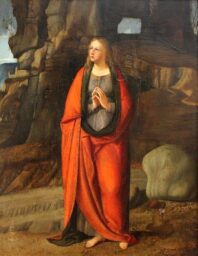
If the disciples had their way this would be all we knew of Mary Magdalene. But Mary Magdalene was not finished yet. Far from it. She had a mission given to her by her beloved Jesus: spread the good news. Where did she go following the crucifixion? What became of her now she was an outcast? Mary Magdalene did not fade into obscurity. She continued teaching.
Here we have ‘The Magdalene’ by Marco Basaiti, c.1515.
Mary Magdalene was full of the burning new mission: the spread the Good News. It was Mary Magdalene who was asked by Jesus to tell the good news of the resurrection to the other disciples first. And it was Mary Magdalene who was asked by Jesus to tell the other disciples to spread the good news of the resurrection.
Mary Magdalene continued to disseminate the secret teachings of Jesus, to describe her own visions as teachings and to share her own intellectual and spiritual wisdom. Mary Magdalene understood this good news was not only for her but for all. Mary Magdalene explained Jesus being able to continue teaching and communicating to them.
Mary Magdalene was a powerful orator who converted whole populations. But that’s a whole other story for another day – check out my blog: ‘Mary Magdalene in Gaul’!
Feature Image: ‘Mary Magdalene and Jesus by Giotto di Bondone, Scrovegni Chapel, Padua.
